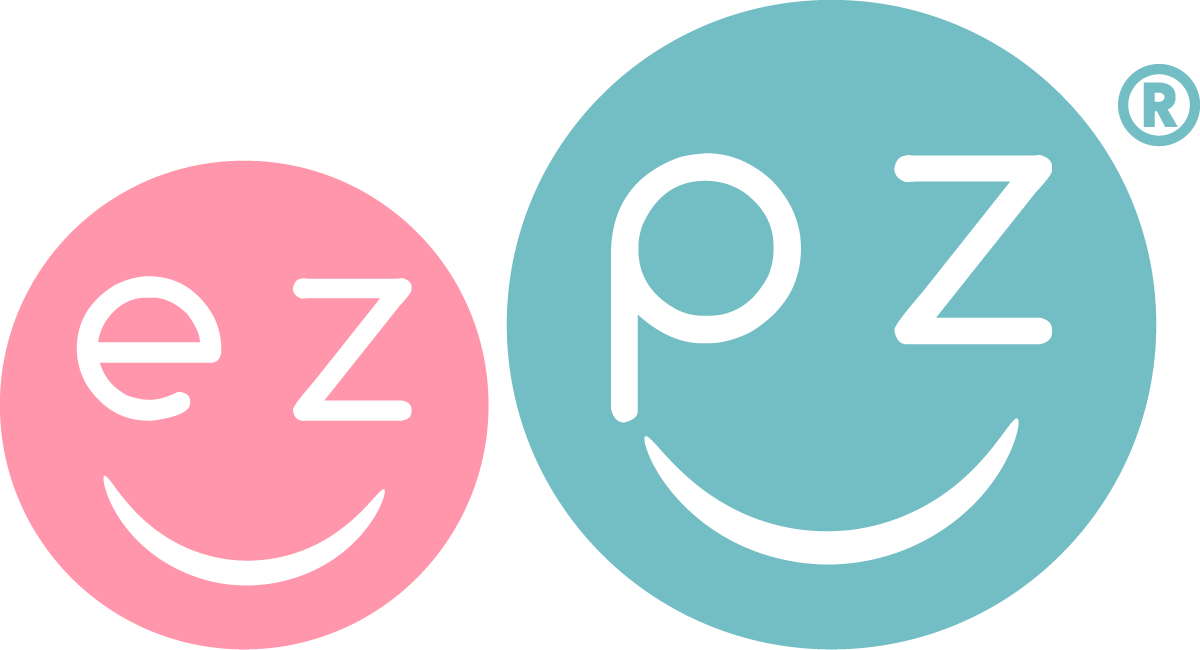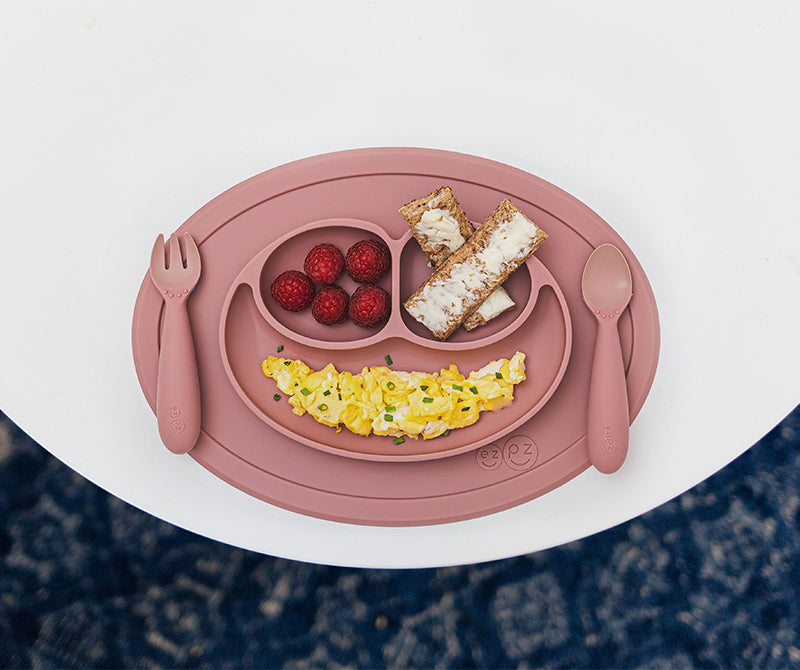There are many feeding transitions that occur when your baby officially turns into a toddler. That first birthday is a huge milestone for swallowing, oral motor, feeding and eating skills. Here are a few feeding changes that occur, plus some expert tips to help you along the way.
- Texture Changes: When you started solids with your baby, you were either serving a variety of purees (traditional method), long + soft strips of food (baby-led weaning) or a combination of both. Once your baby has an established pincer grasp (emerges around 10 months of age) you can start to introduce smaller, soft pieces of food.
-
Making the Change: To make this transition easy for your little one, I recommend only offering one food (out of all the foods that are presented at the meal) in smaller pieces. Continue to offer other foods in the texture that baby is most successful with (purees or strips of food). The ezpz Mini Mat has three compartments purposefully designed for a protein, a fruit / vegetable, and a carbohydrate, which helps to make this change easier for both you and baby. For example, you could offer long strips of moist lamb (familiar texture) in one section of the mat, smaller pieces of avocado (new texture) in the second section, and long strips of toast with butter (familiar texture) in the third section.
- Expert Tip: You can slowly make this transition around 10 months of age with one food at a meal, then two, etc. By twelve months your baby can safely have foods that are pureed, cut into long strips and in smaller pieces.
- Milk Changes: When your little one was a baby you provided them with breast milk or formula as their milk source and primary nutrition. On your baby’s first birthday, you can start offering cow milk or a nut milk alternative. Of course, you can continue to offer a little breast milk or formula, but supplementation of another whole milk during this time is recommended by dietitians and pediatricians.
-
Making the Change: Many families tell me that their toddler had a difficult time transitioning to cow or nut milk. Some find that their little one can’t handle the abrupt change in taste. Other children have difficulties with the change in the texture of the liquid.
- Expert Tip: I recommend a slow transition when introducing milk. I start with a mixture of 80% breast milk (or formula) and 20% cow milk (or nut milk). While following your tots lead, slowly add more cow milk until you are at a 50/50 mixture. Stay at that ratio for a couple of days to a week, making sure your toddler drinks this mixture from a bottle, open cup, and straw cup (which should occur between 9-15 months). Once your little one is drinking this mixture from two of the three containers you can continue reducing the amount of formula.
- Feeding Gear Changes: Now that you officially have a bigger baby (#toddlerlife) your feeding gear will need to get a bit bigger, too!
-
Open Cup: If you were using the Tiny Cup, which was sized for a baby’s face and oral structure, it’s time to transition to the larger Mini Cup + Straw Training System. The Tiny Cup (designed for infants) holds 2 ounces, and the Mini Cup (designed for toddlers) holds 4 ounces.
- Expert Tip: It’s important not to transition to a toddler cup that holds more than 4 ounces, as the overconsumption of milk (and other liquids) is a main contributor to picky eating tendencies. In addition, a 4-ounce cup will help your toddler obtain their swallowing and drinking milestone: By 12 months of age, a toddler will drink from an open cup independently with some spillage. The Mini Cup + Straw Training System is weighted on the bottom and has sensory bumps to help your little one practice open cup drinking with less spills!
-
Fork: From a development and safety standpoint, we don’t introduce a fork to a baby. However, toddlers are expected to learn to self-feed with a fork.
- Expert Tip: Did you know that having your toddler bring a spoon + fork to their mouth (palm up) is a feeding milestone? Once your toddler is successfully scooping with a spoon, they are ready to be introduced to a fork. Show your little one how to pierce food by preloading the Mini Fork, and then allow them to put the fork in their mouth. You may have to preload the fork several times while introducing this new skill.
-
Straw Cup: Being able to drink from a straw independently is an important developmental milestone. The ability to sip, hold their breath and swallow safely is key for drinking independence.
- Expert Tip: When teaching straw drinking, I used to find it hard to teach toddlers where to place their lips on the straw. When designing the Mini Straw, I wanted children to have some tactile input to help with mouth placement. The Mini Cup + Straw Training System has sensory bumps that provide oral awareness for correct mouth placement - and safe drinking!
These feeding changes may require repetition and reinforcement, so be sure to have some yummy food and cold drinks on hand. In no time you will have a toddler rocking these feeding milestones! Be sure to tag us in your toddler adventures by using our hashtag #ezpzfun.



